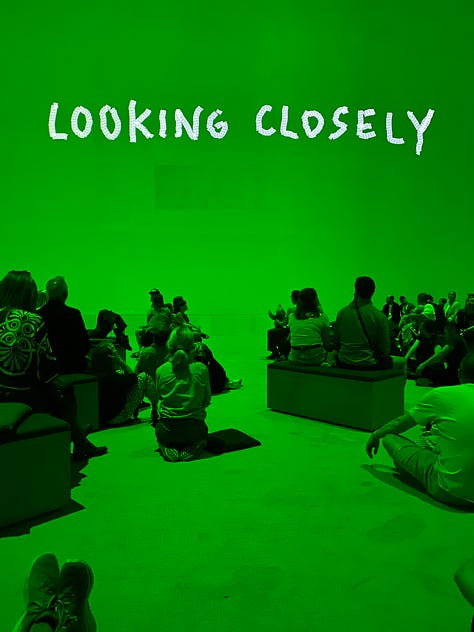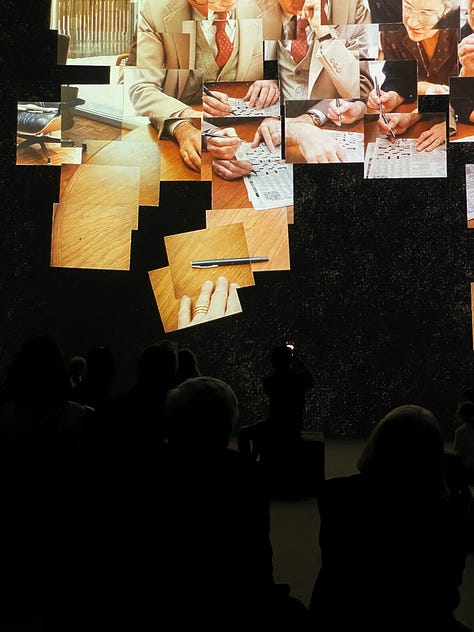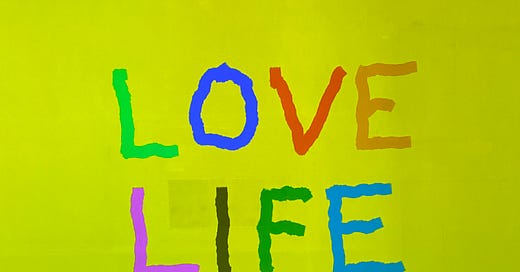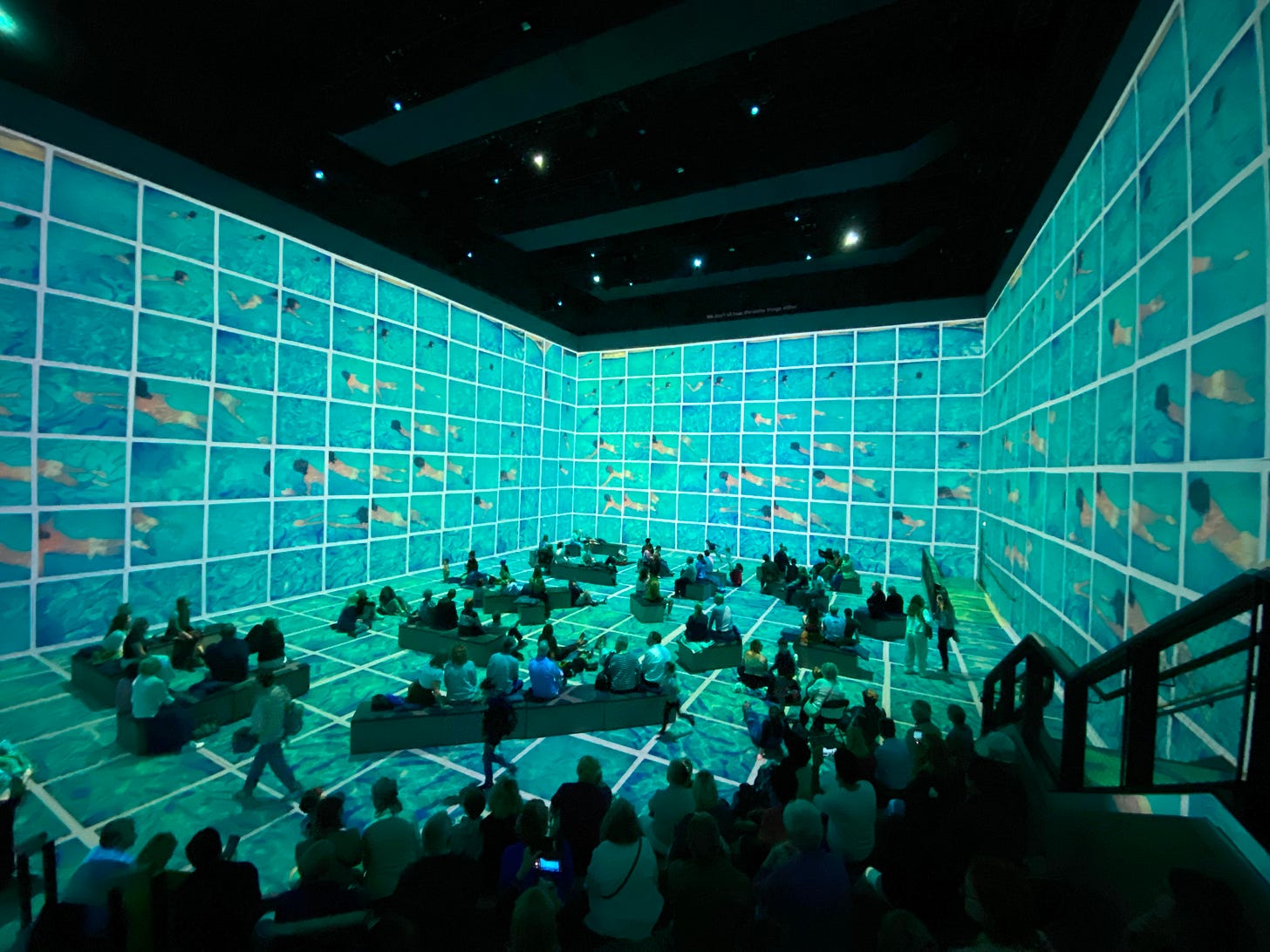📝 On Looking (Bigger and Closer)
3 Lessons from David Hockney's Exhibition in London
I’ve always been a looker. Loads of people say, ‘I never saw that’ — but that’s what artists do. — David Hockney
Ever since I read David Hockney’s Spring Cannot Be Cancelled a few years ago, followed by many of his other books, especially the ones co-written with Martin Gayford (A History of Pictures and Conversations), I haven’t missed a single exhibition of his in London, or in places like Valencia and Cambridge, where it was easy to travel to. The most recent one I visited was his visual storytelling experience at The Lightroom in King’s Cross: David Hockney: Bigger & Closer (not smaller & further away).
It was such a lovely Saturday. I had booked breakfast at Dishoom before the show, which was in a basement just a block away from the restaurant: a large, empty cube where the exhibition is projected in a constant loop.
The immersion comes from both visual and auditory elements. The best part of this was that Hockney narrated it himself, sharing his thoughts and insights as you stood surrounded by his moving paintings projected across all five walls, floor included. Imagine going to an exhibition with David Hockney right next to you, explaining his own work. Yes, a real privilege.
It’s a fascinating and dynamic way to present an exhibition, and a more engaging one, as the artist’s voice guides and educates you while you absorb the visuals. The only downside was that the seating wasn’t particularly comfortable, and, interestingly, the experience was more immersive from the raised entrance level, where you had a better view of the floor projections than on the floor where all the informal seats were placed. Although that would have meant sacrificing the view of the rear wall.
The exhibition itself takes you on a journey through Hockney’s work over the years, exploring recurring themes he’s been consistently drawn to: perspective, photography, theatre, the depiction of water, among others. These are themes he has explored in depth in his books too, but hearing him speak about them while seeing the images come alive made the experience especially rich.



Hockney is always a source of visual wisdom and artistic inspiration. Here are three key ideas I particularly enjoyed and reflected on:
1. Drawing with a Camera
Hockney’s take on photography is truly fascinating. He says that while a photograph is an instant in time, a painting contains time within it. With this thinking, he began experimenting with a series of photo collages: portraits of friends captured with a camera used more like a paintbrush. He assembled these moments into layered compositions, creating an image that contains not just time, but also reflects the way we actually experience seeing. What Hockney calls ‘eye-balling’: some fragments focus on the hands, others on the eyes or the faces, reflecting the natural way our gaze shifts and refocuses. It's a kind of visual wandering that mimics real perception. Space is an illusion, he says. Space is created by time.
Some years ago, I wrote about one of these fascinating photo-collages (although Hockney would call them paintings).
2. Collaboration Is Compromise (On Making Art with Others)
With this statement, Hockney introduces a theme drawn from his theatre design work in the 1980s and collaborations with major opera houses. This struck me hard because as an architect and urban designer, I deeply relate to it.
Contrary to the popular (and romanticised) image of the architect sketching genius ideas on a napkin, our work is profoundly collaborative. Designing a building — or a city, in my case — requires the collaboration of many disciplines and experts: design, planning, engineering (structural, civil, drainage, stormwater, mechanical, electrical, telecom...), landscape architecture, BIM, data management, project management, economics, security, accessibility… to name a few.
Creative collaboration always requires compromise. It’s a negotiation that demands both generosity and assertiveness. Even if the creative work is done individually, collaboration is still essential across many aspects of the creative work. A solo artist may rely on the support of curators, art agents, critics, personal assistants, shop or studio managers, PR professionals, accountants, legal advisors, marketers… A whole ecosystem of roles that help bring the work into the world and make it sustainable. Twyla Tharp even wrote a book on the topic, which I’m looking forward to reading soon: The Collaborative Habit: Life Lessons for Working Together.
3. The Joy of Looking
More than a specific theme, this is a feeling I had through the entire exhibition. Hockney conveys a deep joy in the way he sees the world and practices his craft. Although for him, really, it’s more like play: the joy, the optimism, the curiosity of the world around him, and the thrill of putting what he sees on paper.



Julia Cameron writes:
Curiosity gets us further than curriculum. Serious art requires serious play.
✏️✨
Happy sketching!
Ana






